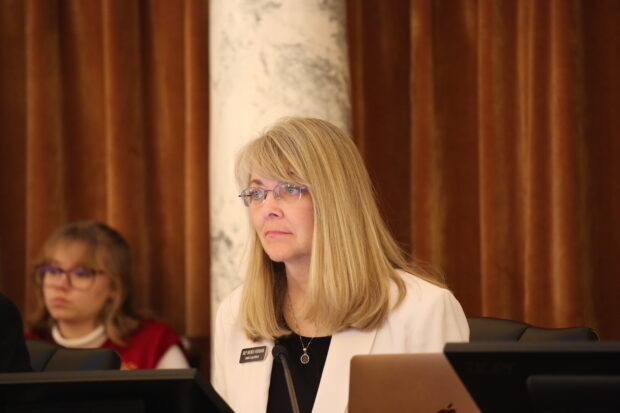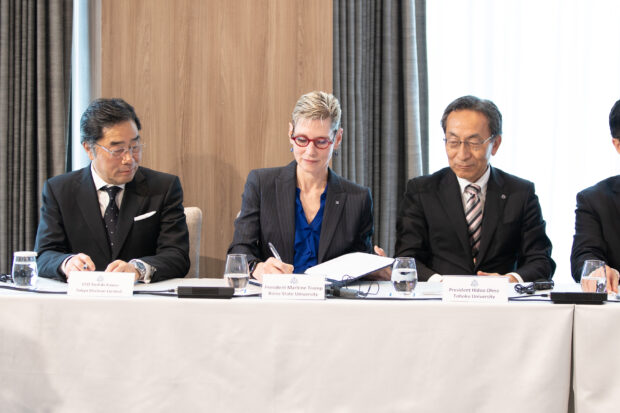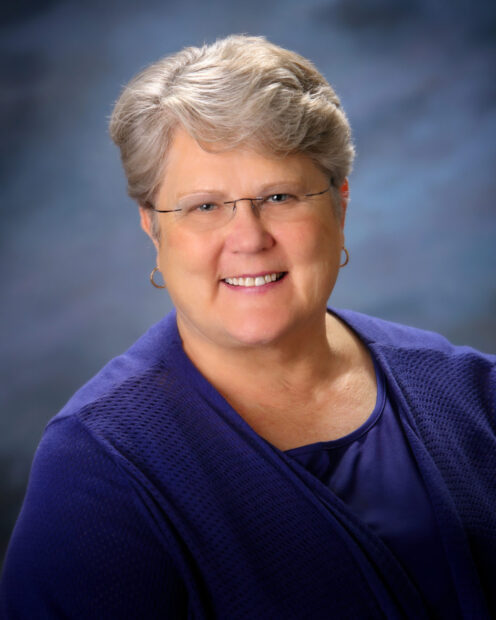
Idaho’s four college and university presidents spent about $150,000 traveling, over a 12-month span.
Using taxpayer and donor dollars, the presidents lobbied at the Statehouse and Capitol Hill, courted potential education partners, rubbed elbows at national committee meetings, cajoled alums and benefactors, and cheered on their football and basketball teams.
They crisscrossed the state, the nation and the world. Boise State University President Marlene Tromp took three overseas trips in the span of about six weeks.
And it didn’t come cheap.
Tromp and University of Idaho President C. Scott Green both outspent Gov. Brad Little's travels. The state's chief executive ran up $48,216.72 in bills.
Idaho Education News filed a series of public records requests to pin down the presidents’ travel — and the cost to taxpayers. EdNews spent several weeks compiling and analyzing the invoices, itineraries and spreadsheets, focusing on travel from July 1, 2022 through June 30. EdNews then submitted detailed, extensive questions to all four institutions.
Presented with the numbers, the head of the State Board of Education offered no criticism. The State Board hires the four presidents — at collective salaries totaling more than $1.6 million — and conducts annual performance reviews each spring.
"The responsibilities of a college or university president are vast, and they must lead in all aspects of their institutions," State Board President Linda Clark said in a statement Friday. "By engaging and developing relationships with other leaders in higher education and private industry, our institution presidents create pathways to recruit students, top faculty, and private sector support."
But a key legislator, state Rep. Wendy Horman, R-Idaho Falls, said the travel costs are “surprisingly high.” Making matters worse, she said, the travel doesn't seem to have much to do with the crucial issues facing higher education — such as access, affordability and student outcomes.
Horman co-chairs the Joint Finance-Appropriations Committee — the powerful legislative committee that writes budgets for all of state government, including higher education. And she says the travel budgets further illustrate the need for strong legislative oversight.
“Are they being good stewards of the taxpayers’ money?” said Horman. “Just because we appropriated it, that’s not the end of the story.”

Marlene Tromp, Boise State University: $49,909.30
On May 23, one day after returning to Boise, Tromp addressed the Boise Metro Chamber of Commerce — regaling business leaders with a recap of her recent travels.
Four nations, 14 states: Marlene Tromp's travels, 2022-23
National Science Foundation, Washington, D.C.
Sun Valley Writers Conference, Sun Valley
Football vs. Oregon State, Corvallis, Ore.
Governor’s Cup, Coeur d’Alene
Football vs. New Mexico, Albuquerque, N.M.
Football vs. UTEP, El Paso, Texas.
Higher education media roundtable, New York, N.Y.
Earlham College inauguration, Richmond, Ind.
State Board of Education meeting, Lewiston.
Football vs. Air Force, Colorado Springs, Colo.
NCAA Board of Directors meeting, Indianapolis, Ind.
Northwest Commission on Colleges and Universities annual conference, Seattle.
Association of Public and Land-Grant Universities and Mountain West Conference commissioners’ meetings, Denver
Football vs. Nevada, Reno, Nev.
Football vs. Wyoming, Laramie, Wyo.
University of Idaho candlelight vigil, Moscow
MWC board of directors meeting, Phoenix, Ariz.
NCAA convention, San Antonio
NWCCU board of commissioners meeting, Seattle
Mountain West Conference tournament, Las Vegas
NCAA tournament, Sacramento, Calif.
Nineteenth Century Studies Association, Sacramento, Calif.
American Council on Education conference, Washington, D.C.
ASU+GSV Conference, San Diego
Idaho Listens, and meeting with Sho-Ban officials, Idaho Falls and Fort Hall
State Board of Education meeting, Moscow
Washington, D.C., meetings with congressional delegation
G7 summit, Hiroshima, Japan
Mountain West Conference board of directors meeting, Honolulu
Harvard Management Development Program, Cambridge, Mass.
International Women’s Forum conference, Helsinki, Finland
NWCCU, Seattle
HATCH, Montreux, Switzerland
Source: Boise State University documents, obtained by Idaho Education News through a public records request | graphic by Jon Sisk
Tromp had spent four days in Hiroshima, Japan, for the G7 global summit. While there, she signed an international agreement, engineered by Boise-based Micron Technology Inc., designed to rework semiconductor curricula at Boise State and 10 other U.S. and Japanese partner universities. She also took a moment to reflect on her personal educational journey, which began while growing up in Green River, Wyo.

“You can come from anywhere,” she told chamber members, “and you can end up at the G7 summit.”
It cost Idaho taxpayers $5,892.69 for Tromp to end up there. The airfare alone cost close to $4,500.
The G7 event was long on ceremony — including a meeting with President Biden, and signing ceremony attended by Secretary of State Antony Blinken and Rahm Emanuel, the U.S. ambassador to Japan. But was there substance? In a written response to EdNews, Tromp said the trip allowed her to tour Micron's facilities in Japan, meet with the other partner universities, and discuss "how Boise State can best prepare students for these crucial jobs of the future."
And Japan wasn’t Tromp’s only overseas destination.
In mid-June, Tromp spent six days in Helsinki, Finland, for an International Women’s Forum conference, at a cost of close to $3,900.
Nine days later, she was on her way to Montreux, Switzerland, for a conference sponsored by HATCH, a nonprofit that says it seeks to provide leaders with a “global network and ecosystem of transformative experiences.” This trip cost taxpayers more than $5,800 — even after Tromp agreed to cover at least part of her airfare, since she took some vacation time while in Europe.
Boise State says Tromp was invited to all three overseas events — as well as national and international conferences on higher education innovation. “President Tromp’s travel reflects Boise State's significance and influence in higher education,” spokesman Mike Sharp said in an email.
And in her written responses to EdNews, Tromp said her travel does not compromise her day-to-day work. "Whenever I travel, I am in regular contact with my team and am accessible to them."
Tromp’s travels covered a wide swath of the planet — and served a variety of functions:
- In May, a week before the G7 Summit, she traveled to Washington, D.C., in a lobbying role, meeting with members of the Idaho congressional delegation.
- The author of several books and articles on the Victorian era, Tromp spent three days in Sacramento, Calif., this spring for a Nineteenth-Century Studies Association conference. Tromp attends one or two such conferences per year. “As a faculty member myself, I remain an active researcher — and advancing research is one of the pillars of our strategic plan," she said.
- As a board member, Tromp attended several meetings of the Mountain West Conference, Boise State’s athletic conference. A member of the NCAA’s Division I board of directors, Tromp attended two meetings of this national athletic governing body. In both cases, the NCAA covered part of Tromp’s expenses.
But many of Tromp’s trips reflect an unwritten role of a university president. As an unabashed Bronco supporter, Tromp makes numerous road trips with Boise State’s athletic teams.
A case in point came in March, when Boise State’s men’s basketball team appeared in the NCAA tournament. Tromp flew to Sacramento, Calif., on March 14 — and according to records provided to EdNews, she appeared to join the team’s chartered flight. After Boise State lost its first-round game on March 16, Tromp caught a flight back to Boise with a donor.
In most cases, Tromp traveled to games at little or no taxpayer cost. She usually flies on the team's charter plane and stays at the team hotel, Sharp said.
“My travel to support student-athletes allows unique opportunities to connect with all of the students I serve, donors and university supporters at large," Tromp said.
But one common thread connects Tromp’s travels: Nearly every trip took her out of Idaho. In the last 12 months, Tromp spent 76 days on the road, and only eight or nine of these travel days were in Idaho. This represents a marked contrast to Tromp’s three colleagues — who spend much of their travel time shuttling to and from Boise, particularly for legislative hearings and State Board of Education meetings.
Boise State provided EdNews with extensive records on Tromp’s travel expenses — including receipts for items as nominal as in-flight WiFi service and airport parking. But the documents also were redacted. In all cases, the university blacked out Tromp’s airline seat assignments — so it’s unclear whether Tromp flew in first class, business class or economy class.
Boise State said this information was exempt from release, citing a section of state law covering most personnel records.
Horman was skeptical.
“I think that that’s a very relevant question for Idaho taxpayers, if they are paying for it,” she said.
Scott Green, University of Idaho: $50,939.19
In mid-May, at the same time Tromp was in Japan, Green was embarking on a $5,942.81 trip of his own.
And he never left the state.

That’s how much it cost Green to preside over graduation ceremonies in Boise and Idaho Falls. The airfare alone cost $4,728.62 — slightly more than it cost Tromp to fly to Hiroshima. That’s because the U of I chartered a plane, which carried Green, six other university officials, and the equipment needed for the ceremonies.
Charter flights account for several of Green’s costliest trips. Green primarily flies commercially, spokeswoman Jodi Walker said, but the limited flights linking Boise with the Palouse doesn’t always work logistically.
One such snag occurred on Sept. 20.
In the morning, Green had to be at the Statehouse for a meeting of the State Land Board, when the panel of elected officials approved the U of I’s plan for a 638-acre dairy research lab near Rupert. Late that afternoon, Green needed to be back on campus for a ceremony renaming a medical education building in honor of the family of a major donor.
Green took a commercial flight to Boise, and returned via charter.
The use of the charters comes as the U of I subsidizes commercial air service to Pullman, Wash., the airport serving the Palouse. In 2002, the U of I brokered a deal with Alaska Airlines to offer five nonstop flights per week between Boise and Pullman — and offered to subsidize Alaska if the flights didn’t yield a 10% profit.
The U of I paid Alaska $400,000 in 2022, and another $400,000 this year.
However, the university says donors covered the vast majority of Green’s travel costs.
Over the past 12 months, Green used slightly more than $46,000 from a president’s reserve fund, composed entirely of donor dollars, Walker said. The remaining travel costs, slightly less than $5,000, came from taxpayer funds.
All told, Green spent 96 days on travel last year, the most of the four presidents. Much of this travel — from donor visits to legislative hearings and State Board meetings — took place in Idaho.
But one pivotal out-of-state trip goes unexplained on spreadsheets provided to EdNews.
On April 11, Green flew to Washington, D.C., for a meeting of the American Council on Education. Before returning to Moscow on April 17, Green made a detour to San Diego.
The spreadsheet does not mention the purpose for Green’s San Diego trip: face-to-face meetings with University of Phoenix officials.
A month later, on May 17, the U of I abruptly went public with a $685 million plan to acquire the for-profit online university.
Kevin Satterlee, Idaho State University: $31,818.62
The retiring president spent 58 days on the road in in the past 12 months — but according to spreadsheets provided to EdNews, he spent almost all of that time in Idaho.
Most of Satterlee’s trips took him from Pocatello to the Treasure Valley, for legislative hearings or meetings in Boise or at Idaho State’s Meridian campus.

Two of these trips were tied, at least partially, to athletics.
A two-day, $1,850 trip to Boise in December incorporated interviews for Idaho State’s football coaching vacancy.
Like Green, Satterlee came to Boise in March for the Big Sky Conference’s men’s and women’s basketball tournaments. The conference holds its annual presidents’ meeting in conjunction with the tournament. Over six days, Satterlee also met with donors and university supporters and spoke to the Idaho Idea Network of Biomedical Research Excellence, a university research collaborative. Satterlee’s trip cost close to $2,800.
Satterlee drove for all of his trips to Boise, the university said in a written response to EdNews.
Satterlee appeared to take only two out-of-state trips last year, and one was a one-day Big Sky Conference meeting in Utah. In July, he went to Portland, Ore., to attend a conference of the American Association of State Colleges and Universities, a Washington, D.C.-based organization that says it focuses on a “shared commitment to make affordable, high-quality education available to students of all backgrounds, races, and ethnicities.”
The AASCU trip cost slightly more than $1,500. The university says it was the only time Satterlee flew on business last year.
Cynthia Pemberton, Lewis-Clark State College: $17,849.68
It cost more than $5,700 for Pemberton to attend AASCU conferences in Portland, Ore., and Washington, D.C. AASCU has 350 members nationally; Lewis-Clark is its sole Idaho member.

It also cost close to $4,400 for Pemberton to attend National Association of Intercollegiate Athletics conferences in Kansas City, Mo., and New Orleans. “Beyond the general importance of intercollegiate athletics to the college and its student-athletes, LC State hosts the NAIA’s national baseball championship, a trademark event of the college and one with a significant economic impact on the college, the region, and Idaho,” college spokesman Logan Fowler said in an email.
Still, the bulk of Pemberton’s time away from her Lewiston office was spent in Idaho — particularly in Boise, for legislative hearings and State Board meetings.
She spent up to 55 days out of the office last year, but that isn’t a precise figure. According to a spreadsheet provided to EdNews, Pemberton spent nine days in June attending a State Board meeting in Pocatello, and meeting with Idaho Department of Correction officials in Boise. (Lewis-Clark is seeking to expand its course offerings in the state’s prisons.) But that nine days included some personal travel that wasn’t done at state’s expense, said Julie Crea, the college’s vice president for finance and administration.
‘(We) expect our presidents to be mindful of cost'
When is business travel no longer essential public outreach — a university president’s job? When does it become a drain on public dollars? When does institutional advancement give way to personal advancement?
Asked about the presidents’ travel bills, Horman came back to one issue: the return on taxpayer investment. “Was their presence essential at these meetings? Was it absolutely necessary for them to be present at these meetings?”

But Clark says taxpayers are getting a return on their money. And despite the high out-of-pocket costs, Clark singled out Tromp's trip to G7 summit as a good example of travel that could pay dividends for the university, its students, Micron and the entire state.
"Our college and university presidents are CEOs, and these leaders travel whether they work in the public or private sectors," Clark said. "Their stature as thought leaders in higher education positively impacts institutional brand on a statewide, regional, national and sometimes on a global scale."
The State Board noted that the presidents have to follow policies from the board and the state controller's office, which require employees to travel as inexpensively as possible. "The intention is that all travelers ... embrace the concepts of 'cost-effective' and 'efficient methods,"' the controller's office policy says.
Said Clark, "I and my fellow board members expect our presidents to be mindful of cost whenever they travel."
